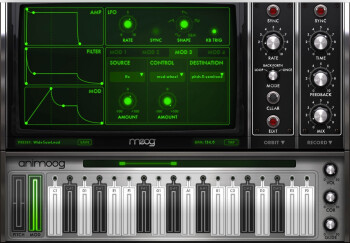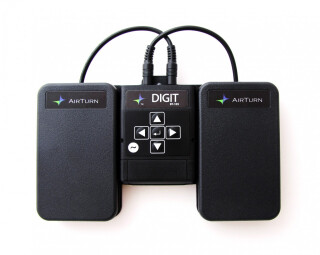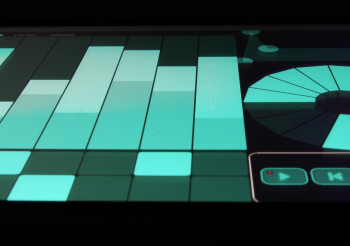With the right apps and accessories, an iPhone, an iPod touch and especially an iPad can be a real boon to your live performance setup. Your iDevice can function as a sound source, effects processor, as a controller for hardware, and more. Let’s peruse the possibilities.
Tiny synth, big sounds
One of the more obvious uses for an iDevice onstage is as a sound source for a keyboard setup. If you want to access some additional sounds without lugging an extra keyboard around with you, there are lots of great synth apps available. So how do you integrate them into your rig?
First, you’ll need an iOS audio and MIDI interface. Many are available, from the pocket-sized, but very capable, IK Multimedia iRig PRO to tabletop units like the PreSonus Audiobox iOne and iTwo, the Apogee Duet, and the Roland Duo-Capture EX, to name just some. If you have an iPad, you can use one of the “dock”-type interfaces on the market, such as the Alesis IO Dock II, Focusrite iTrack Dock, and Behringer iS202. Just make sure it’s compatible with your iPad model, as not all the dock interfaces fit all models, because of size differences between different iPads.
Another option is to use a compatible USB interface, connected to your iDevice via one of Apple’s camera adapters (which essentially turn your dock connector into a USB jack). For newer devices with Lightning connectors, use the Apple Lightning to USB Camera Adapter. For older devices with 30-pin connectors, use the Apple Camera Connection Kit. Not all USB interfaces will work with iOS, so be sure to check before buying.
|
The Moog Music Animoog is a highly regarded synth designed exclusively for iOS
|
Why do you need a MIDI and audio interface if you’re just using your iPhone or iPad as a MIDI sound source? The answer is you need an audio output to go to your keyboard amp or the PA, and although you could use the iDevice’s headphone output in a pinch, it’s not ideal. You’d have to use an adapter cable to turn the stereo 1/8” headphone output of your iDevice into a pair of 1/4” outputs, and the output jack itself isn’t designed for rugged, onstage applications. On the other hand, virtually any audio/MIDI interface will have line-level 1/4” line outputs that you can use for your amp or PA connections.
Depending on the interface, you’ll connect your MIDI keyboard to your iDevice with a standard MIDI cable or a USB-MIDI cable. As for apps, there are synths galore. In a previous article, we spotlighted five excellent and inexpensive ones. You can find app versions of classic synths and new ones like the highly regarded Animoog, among many others. You can also find plenty of high-quality, acoustic and electric piano instruments, samplers and more. Just make sure the app is Core MIDI compatible, or it won’t respond to your controller.
What, no amp?
If you’re a guitar player, there are quite a few virtual amp and effects apps that could be integrated into your stage rig in a number of different ways. (We looked at six of those apps in this recent Audofanzine story.) You could use such an app running on your iDevice for all your amp and effects sounds, and plug it directly into the PA via an audio interface. It’s probably not something you’d want to do except in a pinch, if your amp broke down, or if you had no way to carry it to a gig. Still, it is possible.
A more practical application would be to use your iPhone, iPad or iPod touch as an additional effects processor, integrated with your amp and any stompboxes might have. Most of the virtual amp and effects apps available on the app store give you access to a huge range of effects, way more than you could comfortably fit on a pedalboard. Or, you could go out of your iDevice through an audio interface and directly into an amp, using the app as your entire effects rig.
If you’re planning on connecting your iDevice to your amp or pedalboard, you want an interface with an instrument-level output, for example the Line 6 SonicPort. For going into the PA, you’d need an interface with a line-level output, or you could take your chances with using the headphone output on your iDevice and an adapter cable, and totally eschew an interface, as was mentioned in the keyboard section. But for the same reasons already stated, it’s not your best option.
You could even control your apps with your feet, pedalboard style, with a device like the IK Multimedia iRig Blueboard, which allows you to send control change messages to your apps via Bluetooth, so you can remotely change patches, and turn on and off switches on virtual effects, and even control wah and volume (using an optional expression pedal).
When considering using amp and effects apps for a live rig, there’s one important caveat: Depending on the app and hardware you’re using, you often get some degree of latency. If you have a low tolerance for it, you may be uncomfortable.
Turn the page
Another important onstage application for your iPad, especially, is as a score and lyric reader. Apps are available that let you import and display sheet music and your own charts (in the form of PDFs) so that you can read your parts from stage without the need for physical charts or lyric sheets. There are many score reading apps out there, but two of the most prominent are Deep Dish Designs GigBook and forScore by forScore LLC.
Any app that can display PDFs can also be used for lyrics and set lists. But if you need to read notation onstage, it helps to have a specialized app that is able to respond to a Bluetooth page turner pedal, such as those made by companies like PageFlip or AirTurn. These devices allow you to initiate page turns with your feet, which is a lot easier than having to stop constantly to swipe the screen with your finger in the middle of a song.
Specializes setlist apps are also available, which let you enter in the names of all your songs, and then organize them in savable lists. Imagine the convenience of having the setlist from every gig your band has played, available for easy recall.
Hold it right there
An accessory you’ll need for virtually any onstage iOS application is a stand adapter or other type of holder for your device. It’s a must if you’re going to be reading music or lyrics onstage. Yes, you could put your iPad on a music stand, but it would be vulnerable to being knocked over and damaged. A stand adapter allows you securely connect your iPad to the pole portion of a mic stand, and most give you the ability to adjust the orientation freely as well as the viewing angle.
Quite a few companies make stand adapters, including Ultimate Support, On-Stage Stands, IK Multimedia, Peavey and K&M, among others. You can also purchase stand adapters for the iPhone and iPod touch, but there are not nearly as many available.
Control freak
Another area in which iOS devices, especially iPads, are being used onstage is as controllers for hardware. You can get MIDI/OSC (Open Sound Control) controllers such as the Liine Lemur, which can be used to control hardware synths and other MIDI- or OSC-capable devices. The Lemur app now sells for only $24.99, which is a fraction of what the hardware version (no longer available) cost, and it’s even more powerful. If you’re running Ableton Live on a computer onstage, Lemur offers a host of control options.
You also find dedicated control apps for various hardware devices. Line 6’s AMPLIFi products, which include both amps and a multieffects pedalboard, come with control apps (for iPhone and iPad) that allow you to edit and switch patches from your device.
Makers of digital mixers have been integrating iPad control apps into their systems. Some examples include the Mackie DL series of mixers, and the Behringer X32 mixer. Having mixer control on an iPad lets a soundperson walk around the venue during soundcheck, listening to how things sound in different parts of the room, and making instant adjustments. It also lets you easily save and recall setups for the different venues you play.
Aye aye iOS
Your iOS device is like an Swiss-Army Knife for the stage, offering a wide selection of tools for the performing musician, with the promise for even more handy functionality in the future. Considering that the price of apps is so much less than for Mac or Windows software, using an iOS device to handle the onstage functions you might have used a laptop for in the past, also makes sense economically.



